The Evolution of Self-Checkout
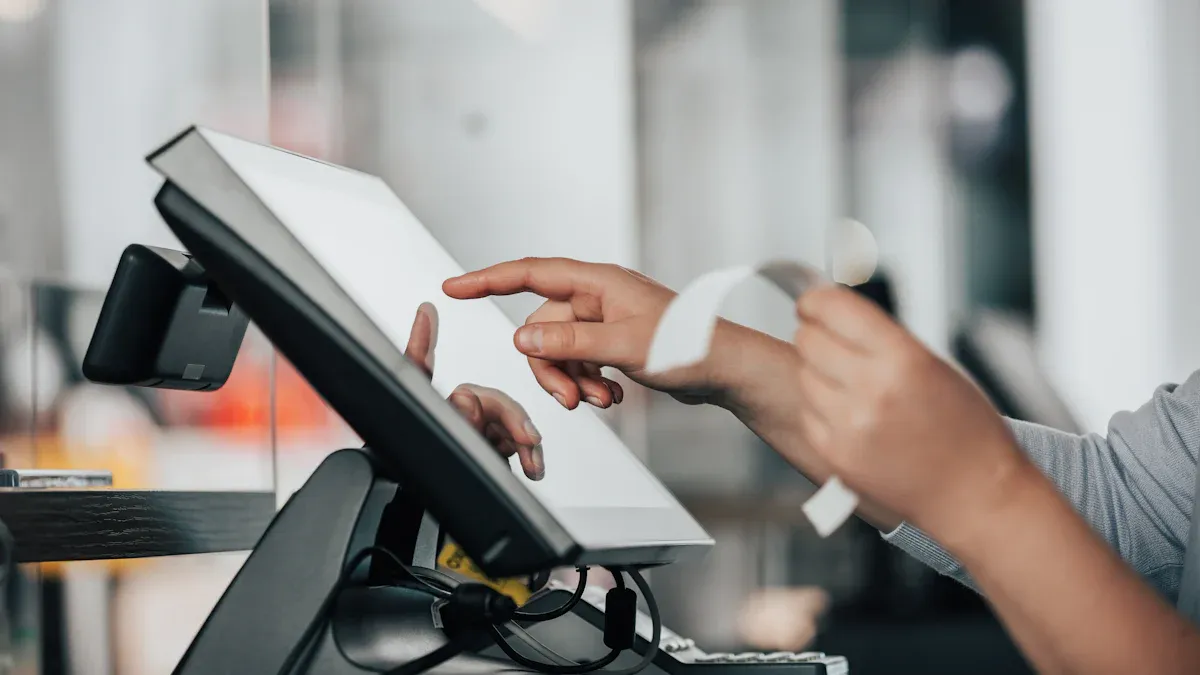
Imagine walking into a store, picking up what you need, and leaving without waiting in line. This simple yet revolutionary concept defines self-checkout, a technology that has reshaped modern retail. In Germany, self-checkouts are thriving in food retail, offering flexible payment options and enhancing convenience. Globally, the self-service technologies market is on track to surpass $42 billion by 2023, reflecting its rising demand. This evolution of self-checkout not only saves you time but also creates a smoother shopping experience, making it an essential part of today’s retail landscape.
Key Takeaways
Self-checkout makes shopping easier. You can scan and pay fast. This saves time and improves your shopping experience.
New technology like AI and mobile payments is improving self-checkout. It makes buying things quicker and solves common problems for shoppers.
Stores save money with self-checkout by needing fewer workers. They also learn about what customers buy to improve stock and ads.
Self-checkout has some problems, like being hard to use or unsafe. Stores must balance using machines and helping customers.
The future of self-checkout looks exciting. Ideas like no-checkout stores and smarter tech will change shopping and make it better for you.
The Origins of Self-Checkout
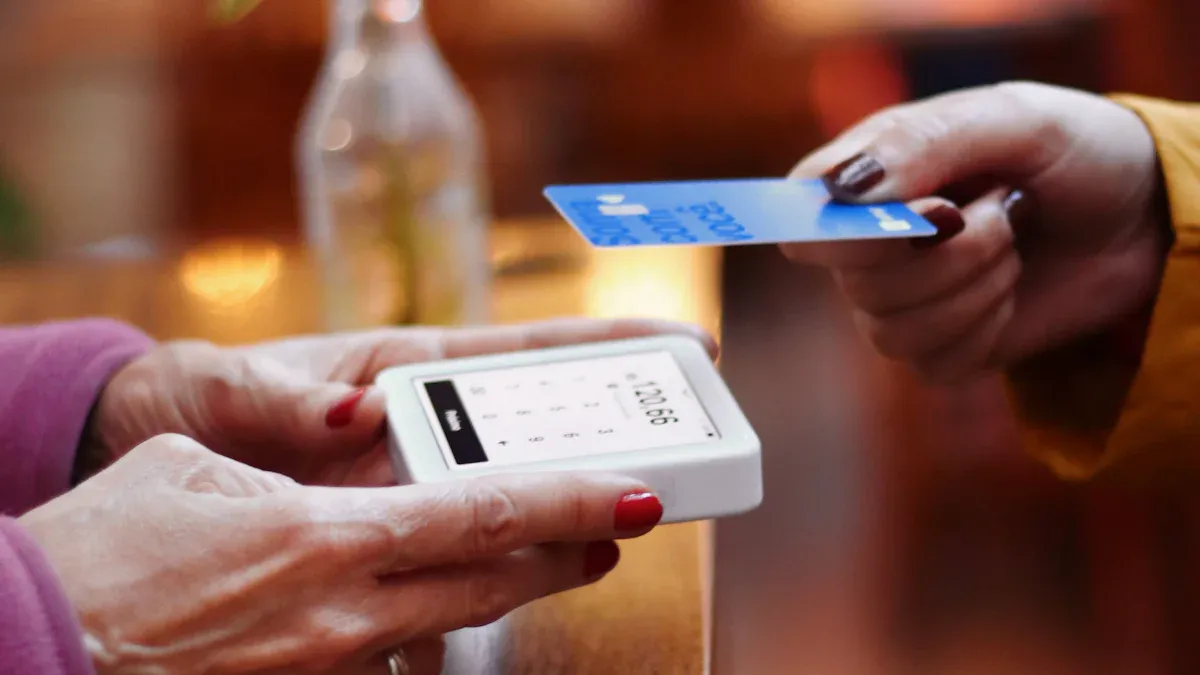
Early Innovations in Self-Checkout
The journey of self-checkout began with a simple observation. In 1984, David R. Humble noticed a customer growing impatient in a long checkout line. This moment sparked the idea of creating a system that allowed shoppers to scan and pay for items themselves. Humble proposed this concept to CheckRobot, a company that later developed the first self-checkout technology. By 1986, Kroger, a major grocery chain, introduced the first self-checkout machine in Atlanta. This innovation marked the beginning of a new era in retail, where technology started to replace traditional cashier roles.
The First Commercial Systems
The late 1990s and early 2000s saw the rise and growth of self-checkout systems in grocery stores. These systems aimed to reduce labor costs and improve customer satisfaction. By 2023, nearly 55% of grocery transactions occurred at self-checkout stations, and 96% of grocery stores offered this option. Early systems allowed customers to scan items, bag them, and pay without assistance. However, some retailers faced challenges, such as higher loss rates and customer frustration with technical glitches. Despite these hurdles, the adoption of self-checkout continued to grow, driven by the demand for faster and more convenient shopping experiences.
Key Milestones in the Evolution of Self-Checkout
The evolution of self-checkout has been shaped by several key milestones. In the 1990s, self-service checkout terminals emerged as cost-saving solutions. By 2013, customer feedback highlighted frustrations with these systems, leading to improvements in design and functionality. The introduction of "scan and go" systems in 2018 offered a more autonomous experience, although low participation rates led some retailers to pause these initiatives. More recently, advancements like AI-powered smart carts and autonomous checkout solutions have redefined the shopping experience. These innovations aim to address past challenges while aligning with modern consumer preferences.
Did you know? The global market for self-checkout systems is projected to grow from $11.041 billion in 2020 to $38.295 billion by 2027, driven by the need for efficiency and enhanced customer experiences.
The Current State of Self-Checkout
Adoption Trends Across Retail Sectors
Self-checkout has become a cornerstone of the retail checkout process, with adoption rates steadily climbing across various sectors. Grocery stores lead the way, with 96% offering self-checkout options. Convenience and fuel retailers are also embracing this technology, with 34% having mature systems and 37% piloting new solutions. Globally, over 217,000 self-checkout kiosks were delivered in 2023, marking a 12% year-over-year increase. Projections suggest that by 2030, more than 24,000 stores will feature self-checkout systems.
The pandemic accelerated the shift toward contactless shopping, driving demand for safer and more efficient checkout methods. Retailers are now investing in innovative solutions to meet these evolving consumer preferences. In North America, which holds over 35% of the global market share, self-checkout adoption reflects the growing desire for convenience and speed.
Tip: Self-checkout kiosks not only enhance customer satisfaction but also improve store layouts and reduce labor costs, making them a win-win for both shoppers and retailers.
Technological Advancements in Self-Checkout
Advancements in technology have transformed the self-checkout experience. AI applications now enhance customer interaction and operational efficiency. Digital shopping carts streamline the retail checkout process, while theft prevention measures reduce losses. Touchless payments, biometric authentication, and smart carts are also gaining traction, offering a futuristic shopping experience.
Retailers are leveraging machine learning to personalize recommendations based on purchase patterns. This not only improves customer engagement but also boosts sales. AI-powered algorithms further enhance fault detection, ensuring a smoother checkout process. These innovations demonstrate how technology continues to redefine self-checkout systems.
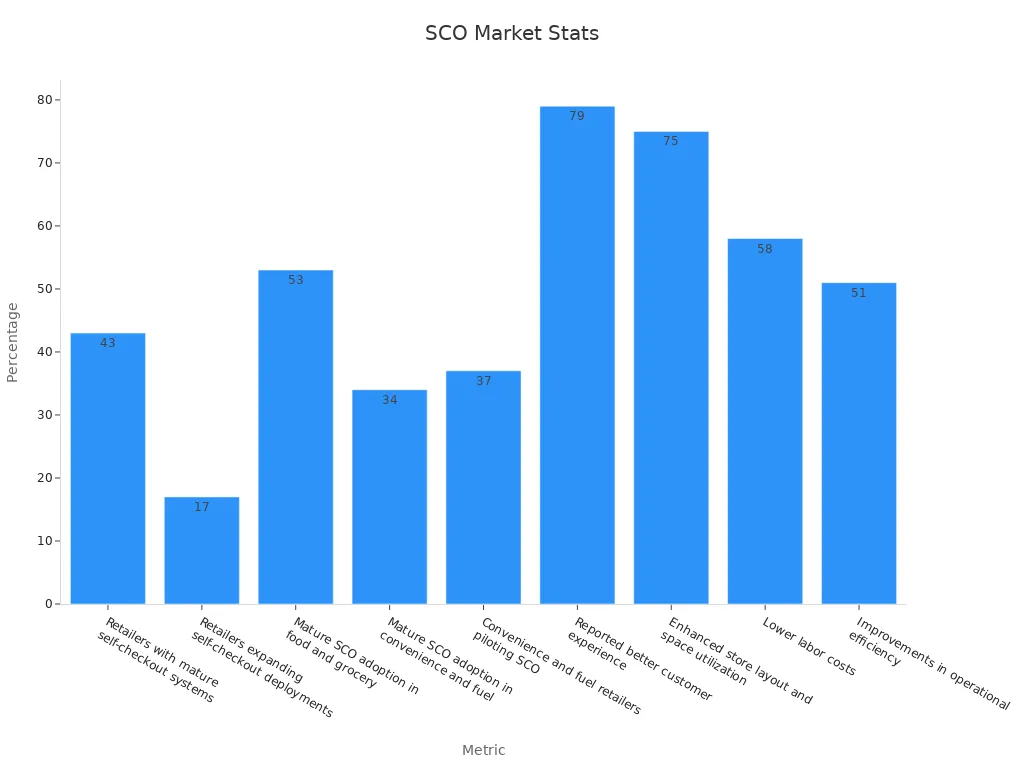
Cloudpick’s Role in Modern Self-Checkout Solutions
Cloudpick stands at the forefront of self-checkout innovation. Its technology powers over 200 stores across 13 countries, showcasing its global impact. By integrating AI-powered inventory management systems, Cloudpick helps retailers optimize stock levels and reduce waste. This not only enhances operational efficiency but also supports sustainability efforts.
Cloudpick’s unmanned store solutions redefine the retail checkout process. Features like real-time monitoring, smart replenishment, and personalized marketing create a seamless shopping experience. These advancements align with modern consumer demands, making Cloudpick a leader in the self-checkout revolution.
Benefits of Self-Checkout
Enhanced Customer Convenience
Self-checkout systems have revolutionized the way you shop by making the process faster and more convenient. Instead of waiting in long lines, you can quickly scan, bag, and pay for your items. This streamlined process saves time and enhances your overall shopping experience. A recent survey revealed that 77% of shoppers prefer self-checkout for its speed, while 36% appreciate shorter lines. Additionally, 43% of customers enjoy the ability to bag their items at their own pace.
Evidence Type | Finding | Percentage |
|---|---|---|
Preference for Speed | Shoppers prefer self-checkout for speed | 77% |
Preference for Shorter Lines | Shoppers prefer self-checkout for shorter lines | 36% |
Preference for Bagging | Shoppers prefer self-checkout for bagging items | 43% |
Gen Z Preference | Gen Z shoppers prefer self-checkout | 63% |
Millennial Preference | Millennial shoppers prefer self-checkout | 45% |
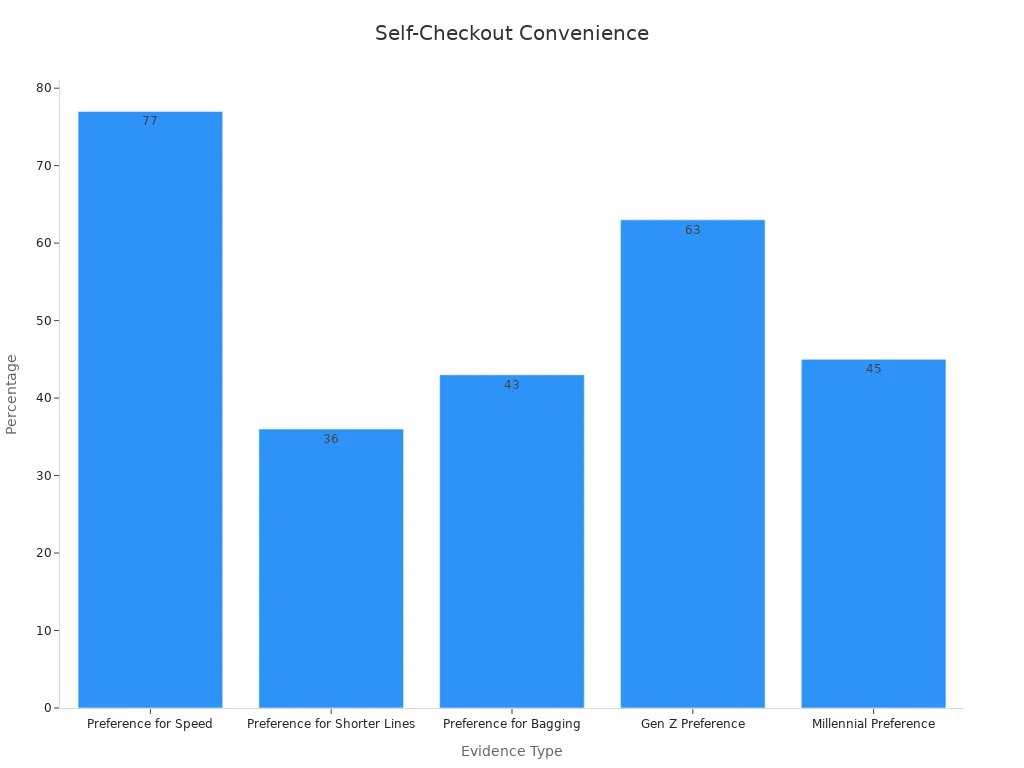
Younger generations, such as Gen Z and Millennials, are particularly drawn to self-service checkout options. With 63% of Gen Z and 45% of Millennials favoring this technology, it’s clear that self-checkout aligns with modern consumer preferences. These systems also support seamless checkout experiences, allowing you to shop without interruptions.
Tip: Retailers that prioritize customer convenience through self-checkout often see higher satisfaction rates and increased loyalty.
Operational Efficiency for Businesses
Self-checkout systems not only benefit customers but also improve operational efficiency for businesses. By reducing wait times at traditional cashier lanes, these systems speed up transactions by an average of 30%. This efficiency often leads to higher sales, with 91% of retailers reporting positive outcomes.
Self-service checkout systems also collect valuable data on purchasing patterns. This data helps businesses optimize inventory and tailor marketing strategies to meet customer needs. For example, stores can identify popular products and ensure they remain in stock, enhancing the shopping experience.
Another significant advantage is the reduction in labor costs. Self-checkout lanes allow businesses to reallocate staff to other critical areas, such as customer service or inventory management. This efficient use of resources not only lowers operational expenses but also improves overall store performance.
Environmental and Cost-Saving Advantages
Self-checkout systems contribute to environmental sustainability by reducing paper waste and energy consumption. Many systems now offer digital receipts, minimizing the need for printed copies. Additionally, these systems often use energy-efficient technologies, which lower the carbon footprint of retail operations.
From a cost-saving perspective, self-checkout reduces the need for extensive cashier staffing. This allows businesses to invest in other areas, such as technology upgrades or customer engagement initiatives. The streamlined operations also result in fewer errors during transactions, saving both time and money.
Did you know? Self-checkout systems not only enhance efficiency but also align with eco-friendly practices, making them a win-win solution for businesses and the environment.
Challenges of Self-Checkout
Addressing Usability Concerns
Self-checkout systems aim to simplify shopping, but they often face usability challenges. Many customers find these systems confusing, especially when machines fail to scan items correctly or require manual intervention. A Raydiant survey revealed that 25.1% of users experienced technical issues, while 21.9% found the process too slow. Some shoppers also dislike bagging their own items, which adds to their frustration.
Retailers like Target have introduced policies to address these concerns. For example, limiting self-checkout to customers with fewer than 10 items has improved satisfaction. However, not all solutions succeed. Booths Supermarkets removed self-checkout systems after customers complained about their unreliability and lack of personal interaction. These examples highlight the importance of designing user-friendly systems that cater to diverse customer needs.
Source | Findings |
|---|---|
Customers prefer traditional checkout for small purchases. | |
Gartner Study (2022) | 38% of Gen Z and Millennials favor self-service; 55% shop less without it. |
Raydiant Survey | 25.1% reported technical issues; 21.9% found self-checkout too slow. |
Target's New Policy | Limits self-checkout to fewer than 10 items for better satisfaction. |
Booths Supermarkets | Removed self-checkout due to customer complaints about unreliability. |
Note: Retailers must balance automation with customer expectations to ensure a positive shopping experience.
Security and Anti-Theft Measures
While self-checkout offers convenience, it also presents security challenges. Theft rates at self-checkout stations are up to five times higher than at traditional checkouts. Nearly 57% of shoppers admit to "accidentally" failing to scan items, contributing to significant losses. In the UK alone, theft at self-checkout costs retailers £1.6 billion annually.
Retailers combat these issues with advanced security measures. AI-powered cameras monitor transactions in real time, while smart turnstiles prevent tailgating. Some systems use weight sensors to detect unscanned items in bags. Despite these efforts, only 1 in 20–40 shoplifters are caught, highlighting the need for continuous innovation in theft prevention.
Evidence Description | Value |
|---|---|
Up to 5 times higher | |
Percentage of shoppers admitting to theft at SCOs | 19–30% |
Percentage of respondents who stole after failing to scan | Nearly 57% |
Estimated annual loss in the UK due to theft at SCOs | £1.6 billion |
Percentage of supermarkets with SCOs reporting theft | 86% |
Tip: Retailers can reduce theft by combining technology with staff training and customer education.
Balancing Automation with Employment
The rise of self-checkout has sparked debates about its impact on jobs. Automation puts 6 to 7.5 million U.S. retail jobs at risk, with smaller communities facing the greatest challenges. Retail workers, whose average age is 38, often rely on these jobs for financial stability. In fact, 36% of retail employees receive public assistance.
However, automation also creates opportunities. By 2030, up to 555 million new jobs could offset the 400 million displaced by technology. Workers will need to develop skills like critical thinking and creativity to thrive in this changing landscape. Collaboration among governments, businesses, and schools is essential to prepare the workforce for these shifts.
Finding | Detail |
|---|---|
Jobs at Risk | 6 to 7.5 million U.S. retail jobs are at risk due to automation. |
Public Assistance | 36% of retail workers receive public assistance. |
Average Age | The average retail worker is age 38. |
Community Impact | Smaller communities face greater risks from retail automation. |
New Job Opportunities | 555 million new jobs could offset 400 million displaced jobs by 2030. |
Did you know? Automation in retail could lead to both challenges and opportunities, making workforce preparation crucial.
Emerging Trends and Innovations
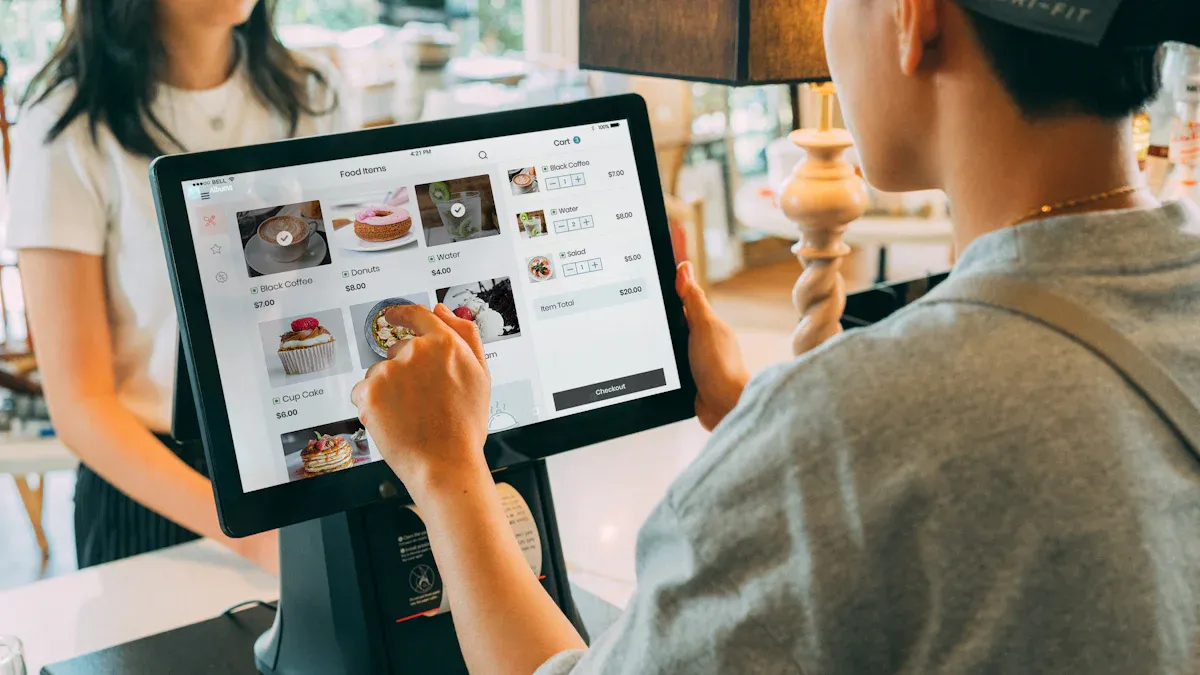
AI-Powered Self-Checkout Systems
AI-powered self-checkout systems are transforming the retail landscape. These systems use advanced algorithms to streamline transactions, reduce errors, and enhance customer satisfaction. Innovations like voice-activated kiosks and mobile checkout options are gaining popularity, offering a futuristic shopping experience. Retailers are adopting these technologies to improve efficiency and reduce shrinkage. For example, Diebold Nixdorf’s AI-driven solutions have set new benchmarks in theft prevention and operational accuracy.
The market for self-checkout systems is growing rapidly. By 2030, it is expected to reach $11.09 billion, reflecting a compound annual growth rate (CAGR) of 13.68%. This growth highlights the increasing demand for contactless shopping experiences. Consumers now prefer minimal physical interaction, especially in busy retail environments. AI-powered systems cater to these preferences, making shopping faster and more convenient.
Evidence Type | Details |
|---|---|
Market Growth Rate | The global market of self-checkout is expected to expand by a CAGR of 11.6% between 2021 and 2026. |
Customer Preference | 85% of GenZ population prefers self-checkout systems, opting for kiosks. |
Technological Advancements | Innovations include voice-activated systems and mobile checkout options using AI technology. |
Tip: AI-powered self-checkout systems not only enhance efficiency but also improve customer engagement through personalized shopping experiences.
The Role of Cloudpick’s Unmanned Store in Retail Innovation
Cloudpick’s unmanned store technology is revolutionizing retail by eliminating traditional checkout lines. These stores use computer vision and synthetic data to identify products and monitor customer activity. This automated system ensures accurate inventory tracking, reducing discrepancies and enhancing operational efficiency. Features like real-time monitoring and smart replenishment create a seamless shopping experience.
Cloudpick’s impact on the retail sector is measurable. Automated operations reduce labor costs, while efficient checkout processes save time for customers. The technology sets new standards in customer service, offering personalized marketing and dynamic pricing. With over 200 stores across 13 countries, Cloudpick demonstrates how AI-driven solutions can reshape the retail industry.
Feature | Impact on Retail Sector |
|---|---|
Automated Operations | Reduces labor costs by minimizing the need for human staff. |
Efficient Checkout | Streamlines shopping experience by eliminating checkout lines. |
Real-Time Inventory Management | Ensures accurate stock tracking, reducing discrepancies. |
Note: Cloudpick’s unmanned store technology exemplifies how innovation can redefine retail operations, making shopping more efficient and enjoyable.
The Rise of No-Checkout Stores and Mobile Payments
No-checkout stores and mobile payment solutions are emerging as the future of retail. These stores allow customers to grab items and leave without stopping at a checkout counter. Technologies like Amazon’s "Just Walk Out" system and Cloudpick’s unmanned stores are leading this trend. Mobile wallets are also gaining traction, with users projected to reach 4.8 billion by 2025.
Digital payments are now mainstream, with 82% of Americans using them in 2023. Optimized payment processes reduce cart abandonment rates by 35%, ensuring smoother transactions. Retailers benefit from fraud prevention measures, which save $20 billion annually. Integrated payment solutions also increase customer lifetime value by 67%, highlighting their importance in modern retail.
Mobile wallet users are projected to reach 4.8 billion by 2025, indicating a significant shift towards mobile payments in retail.
73% of consumers consider payment experience when choosing retailers, making payment options a key factor in decision-making.
Global installations of self-checkout terminals are expected to reach two million by 2029, reflecting ongoing growth in this sector.
Did you know? No-checkout stores and mobile payments not only enhance convenience but also improve security and customer satisfaction, making them essential for the future of retail.
The Future of Self-Checkout
Predictions for the Evolution of Self-Checkout
The future of self-checkout looks promising as it continues to evolve with technological advancements and changing consumer habits. By 2030, the self-checkout market is expected to surpass $6 billion, driven by innovations like AI integration and mobile payment systems. These technologies will make the checkout process faster and more efficient, enhancing your shopping experience. Retailers are also focusing on sustainability by reducing waste and using data analytics to improve system performance.
The COVID-19 pandemic has accelerated the demand for contactless shopping, making self-checkout a preferred option for many. You can expect more stores to adopt these systems, offering you a seamless and hygienic way to shop. As these technologies advance, they will cater to your needs better, ensuring a smoother and more personalized experience.
Key trends shaping the future of self-checkout include:
Integration of AI for smarter and faster transactions.
Increased use of mobile payments for convenience.
A focus on sustainability and eco-friendly practices.
Enhanced data analytics for better inventory management.
Cloudpick’s Vision for the Future of Retail
Cloudpick envisions a future where self-checkout systems redefine retail. Its unmanned store technology operates 24/7, giving you the freedom to shop anytime without waiting in line. By using AI, these stores reduce the need for manual oversight, lowering labor costs and improving efficiency. You’ll also benefit from data-driven insights, which optimize product placement and deliver personalized marketing.
Cloudpick’s innovative approach ensures that your shopping experience is not only convenient but also engaging. With features like real-time monitoring and smart replenishment, you’ll always find what you need in stock. This vision aligns with the broader evolution of self-checkout, making Cloudpick a leader in transforming retail.
Highlights of Cloudpick’s vision:
Around-the-clock accessibility for ultimate convenience.
AI-driven operations for cost efficiency.
Data analytics for tailored shopping experiences.
The Impact of Self-Checkout on the Retail Industry
Self-checkout has significantly impacted the retail industry, improving both customer satisfaction and operational efficiency. Faster service speeds and better queue management have enhanced your overall shopping experience. Retailers benefit from reduced labor costs and valuable insights into consumer behavior.
Factor | Impact on Customer Satisfaction |
|---|---|
Speed of Service | Positive |
Technology Functionality | Positive |
Queue Management | Positive |
Overall Customer Experience | Most Critical |
As self-checkout systems evolve, they will continue to shape the retail landscape. You’ll enjoy quicker, more efficient shopping trips, while retailers gain tools to optimize their operations. This mutual benefit ensures that self-checkout remains a cornerstone of modern retail.
The evolution of self-checkout has transformed retail, making shopping faster and more convenient for you. Innovations like AI and mobile payments now address common frustrations, such as scanning items without barcodes. These advancements ensure a smoother experience while meeting your demand for speed and simplicity. For example, 80% of shoppers prefer nontraditional checkout options, and 66% value faster processes to avoid waiting in line.
Cloudpick’s cutting-edge solutions, like its unmanned stores, showcase how technology can redefine retail. By balancing innovation with your needs, self-checkout systems continue to shape a future where shopping is seamless and efficient.
FAQ
What is self-checkout, and how does it work?
Self-checkout allows you to scan, bag, and pay for items without a cashier. You use a kiosk or mobile app to complete the process. Advanced systems use AI to track items and automate payments, making shopping faster and more convenient.
Are self-checkout systems secure?
Yes, most systems use advanced security features like AI-powered cameras, weight sensors, and smart turnstiles. These technologies help prevent theft and ensure accurate transactions. Retailers also monitor systems in real time to address any issues quickly.
How does Cloudpick’s unmanned store differ from traditional self-checkout?
Cloudpick’s unmanned store eliminates checkout lines entirely. You grab items, and AI tracks your selections automatically. Payments happen seamlessly through integrated systems. This approach offers a fully automated, contactless shopping experience, unlike traditional self-checkout kiosks.
Can self-checkout systems reduce environmental impact?
Yes, many systems offer digital receipts and use energy-efficient technologies. These features reduce paper waste and lower energy consumption. By optimizing operations, self-checkout also minimizes resource use, contributing to sustainability efforts.
Will self-checkout replace traditional cashiers?
Self-checkout complements traditional cashiers rather than replacing them entirely. It handles routine transactions, freeing staff for tasks like customer service. This balance ensures efficiency while maintaining a human touch in retail environments.
See Also
Upcoming Changes to Walmart's Self-Checkout System in 2025
Identifying Causes and Fixes for Self-Checkout Cash Mistakes
Vending Machines' Transformation: Embracing Contactless Payment Methods
Common Self-Checkout Mistakes Encountered at Walmart Stores
How Cloudpick's Checkout Technology Improves Customer Experience and Efficiency
